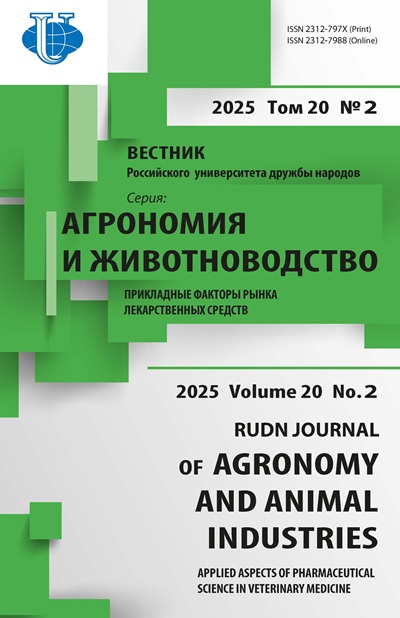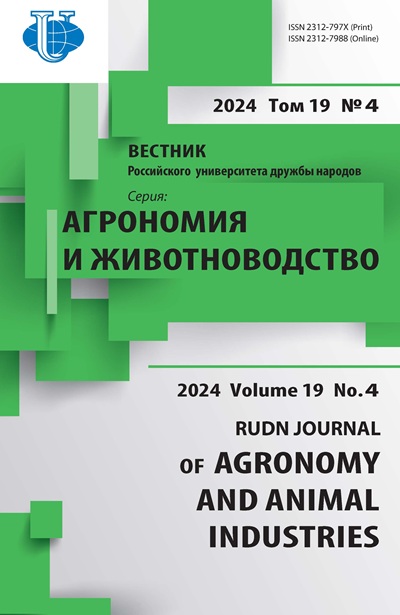Пути формирования воротной вены кошки домашней
- Авторы: Былинская Д.С.1, Щипакин М.В.1
-
Учреждения:
- Санкт-Петербургский государственный университет ветеринарной медицины
- Выпуск: Том 19, № 4 (2024)
- Страницы: 641-650
- Раздел: Морфология и онтогенез животных
- URL: https://journal-vniispk.ru/2312-797X/article/view/315788
- DOI: https://doi.org/10.22363/2312-797X-2024-19-4-641-650
- EDN: https://elibrary.ru/BCMINU
- ID: 315788
Цитировать
Полный текст
Аннотация
Воротная вена является крупным венозным коллектором, собирающим венозную кровь от органов аппарата пищеварения, расположенных в брюшной полости, за исключением каудальной части прямой кишки. Цель исследования — изучить пути формирования воротной вены у кошки домашней, дать венам морфометрическую характеристику. В качестве материалов исследования отобраны из числа доставленных на кафедру анатомии животных Санкт-Петербургского государственного университета ветеринарной медицины из ветеринарных клиник Санкт-Петербурга трупы 15 кошек (средняя масса тела 3500…3800 г.), в анамнезе которых отсутствовали инфекционные болезни, а также болезни со стороны органов желудочно-кишечного тракта. Методы исследования: тонкое анатомическое препарирование и морфометрия. Для тонкого анатомического препарирования в воротную вену предварительно вводили подкрашенный латекс. Установлено: в формировании воротной вены кошки задействованы четыре крупные вены. Селезеночная, правая желудочная, желудочно-двенадцатиперстная осуществляют дренаж крови от желудка кошки домашней. Селезеночная и желудочно-двенадцатиперстная вены также участвуют в формировании путей оттока крови от поджелудочной железы и нисходящей части 12‑перстной кишки. Четвертая ветвь воротной вены — общий ствол брыжеечных вен — формируется путем слияния краниальной и каудальной мезентеральных вен. Краниальная брыжеечная вена собирает кровь от тощей кишки (по крупным тощекишечным венам), от подвздошной, слепой и восходящей ободочной кишок (подвздошно-ободочная вена). От поперечной и нисходящей ободочной кишки, а также проксимального отдела прямой кишки отток крови происходит по системе каудальной брыжеечной вены.
Ключевые слова
Об авторах
Дарья Сергеевна Былинская
Санкт-Петербургский государственный университет ветеринарной медицины
Автор, ответственный за переписку.
Email: goldberg07@mail.ru
ORCID iD: 0000-0001-9997-5630
SPIN-код: 7627-0174
кандидат ветеринарных наук, доцент, доцент кафедры анатомии животных
Российская Федерация, 196084, г. Санкт-Петербург, ул. Черниговская, д. 5Михаил Валентинович Щипакин
Санкт-Петербургский государственный университет ветеринарной медицины
Email: m.shchipakin@yandex.ru
ORCID iD: 0000-0002-2960-3222
SPIN-код: 7521-3140
доктор ветеринарных наук, профессор, заведующий кафедрой анатомии животных
Российская Федерация, 196084, г. Санкт-Петербург, ул. Черниговская, д. 5Список литературы
- Melnikov S, Bylinskaya D, Zelenevskiy N, Shchipakin M, Khvatov V, Glushonok S. Methods for studying the ductus venosus in animals. FASEB Journal. 2022;(36): S1:3727. doi: 10.1096/fasebj.2022.36.S1.R3727
- Sidorova KA, Cheremenina NA, Veremeeva SA, Yesenbaeva KS, Kuzmina EN. Morphofunctional characteristics of rabbit liver. Agro-food policy of Russia. 2012;(12):65—67. (In Russ.).
- Veremeeva SA, Krasnolobova EP, Kozlova SV. Features of the liver in dogs. AIC: innovative technologies. 2018;(1):20—24. (In Russ.).
- Anisimova KA. Anatomy of the liver and bile-excreting system at pigs of breed Landrace at early stages of post-natal ontogenesis. Issues of legal regulation in veterinary medicine. 2017;(1):114—117. (In Russ.).
- Khvatov VA, Zelenevsky NV, Vasiliev DV. Peculiarities of the anatomy of the liver breeding system of the Persian breed cat. In: Current state and prospects of development of veterinary and zootechnical science: conference proceedings. Cheboksary; 2020. p.342—346. (In Russ.).
- Pervukhina IY, Seleznev SB, Esina DI. Ultrasound examination of the pancreas of dogs and cats. Theoretical and applied problems of agro-industry. 2010;(4):7—14. (In Russ.).
- Khvatov VA. Angiography of the portal liver vein of a Siamese cat. In: Actual problems of intensive development of animal husbandry: conference proceedings. Bryansk; 2023. p.331—333. (In Russ.).
- Levitskaya KA, Krasnolobova EP, Veremeeva SA. Anatomical and histological features of the internal organs of the fox. World of Innovation. 2023;(2):49—55. (In Russ.).
- Prusakov AV, Zelenevsky NV, Shchipakin MV, Virunen SV, Bylinskaya DC, Vasiliev DV. Sources of blood supply of the liver of a domestic cat. Issues of legal regulation in veterinary medicine. 2017;(2):123—125. (In Russ.).
- Prusakova AV, Zelenevsky NV. Features of the course and branching of the portal vein of the liver in goats of the Anglo-Nubian breed. In: From inertia to development: conference proceedings. Yekaterinburg; 2020. p.89—90. (In Russ.).
- Polyanskaya AI, Shchipakin MV. The main venous vessels of the stomach of a Yorkshire pig in the age aspect. Legal regulation in veterinary medicine. 2024;(1):105—108. (In Russ.). doi: 10.52419/issn2782—6252.2024.1.105
- Malenkikh NA, Melnikov SI. Venous vascularization of the trunk of a Landrace pig. In: Knowledge of the young for the development of veterinary medicine and the agro-industrial complex of the country: conference proceedings. Saint Petersburg; 2022. p.251—252. (In Russ.).
- Veremeeva SA. Morphological features of the arteries and biliary tract of the dog’s liver. In: Modern trends in the development of science in animal husbandry and veterinary medicine: conference proceedings. Tyumen; 2019. p.78—81. (In Russ.).
- Tabakova MA, Ryadinskaya NI. Histological structure of the liver of Baikal seal. In: Problems of species and age morphology: conference proceedings. Ulan-Ude; 2019. p.125—134. (In Russ.).
- Ryadinskaya NI, Tabakova MA. Anatomy features of structure, topography and blood supply of liver in Baikal seal (Phoca sibirica). Marine mammals of the Holarctic: conference proceedings. Volume 2. Astrakhan; 2018; p.137—142. (In Russ.).
- Barteneva YY, Zelenevskiy NV. The morphology of the liver and gall bladder of Eurasian lynx. Hippology and veterinary medicine. 2013;3(9):94—97. (In Russ.).
Дополнительные файлы











